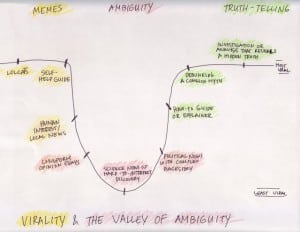
Every PR communicator dreams of their story becoming the next big social media sensation; the story that rocks Facebook and Twitter and provides legitimate brand lift. The odds against creating such a successful campaign are astronomical, but that does not necessarily mean that creating a viral story that spans all of social media is a random phenomenon.
Annalee Newitz, editor-in-chief of io9.com, has made very some interesting observations on the nature of viral journalism.
PR pros, who are grappling with how to create more shareable content, need to take note.
According to Newitz, there is a “valley of ambiguity” in which many stories fall, garnering scant interest in social media. These stories may be thoughtful and well written, but they don’t grab widespread attention. These are the hard scientific reports, data-driven pieces, long form opinion essays and complex political stories. These items are not widely shared because they are intricate and can be misunderstood. And who wants to share a story that might make them look like a fool or offend friends and colleagues?
Communicators want to place their story not in the valley, but on the peaks on either side. This is where viral stories reside. On one side are the memes, those simple bits of information that are positive or make us laugh. On the other side are the investigative, truth-telling pieces that provide hard evidence. These are stories that are informative, but they don’t call for critical thinking and they are not open to opinion or interpretation.
So, if you really want your story to go viral:
- Keep it simple
- Be straightforward
- Appeal to people’s sense of humor
- Give them straight facts
It won’t guarantee the next social media hit, but it will certainly increase the number of eyeballs that see your message.
Follow Richard Brownell: @RickBrownell
